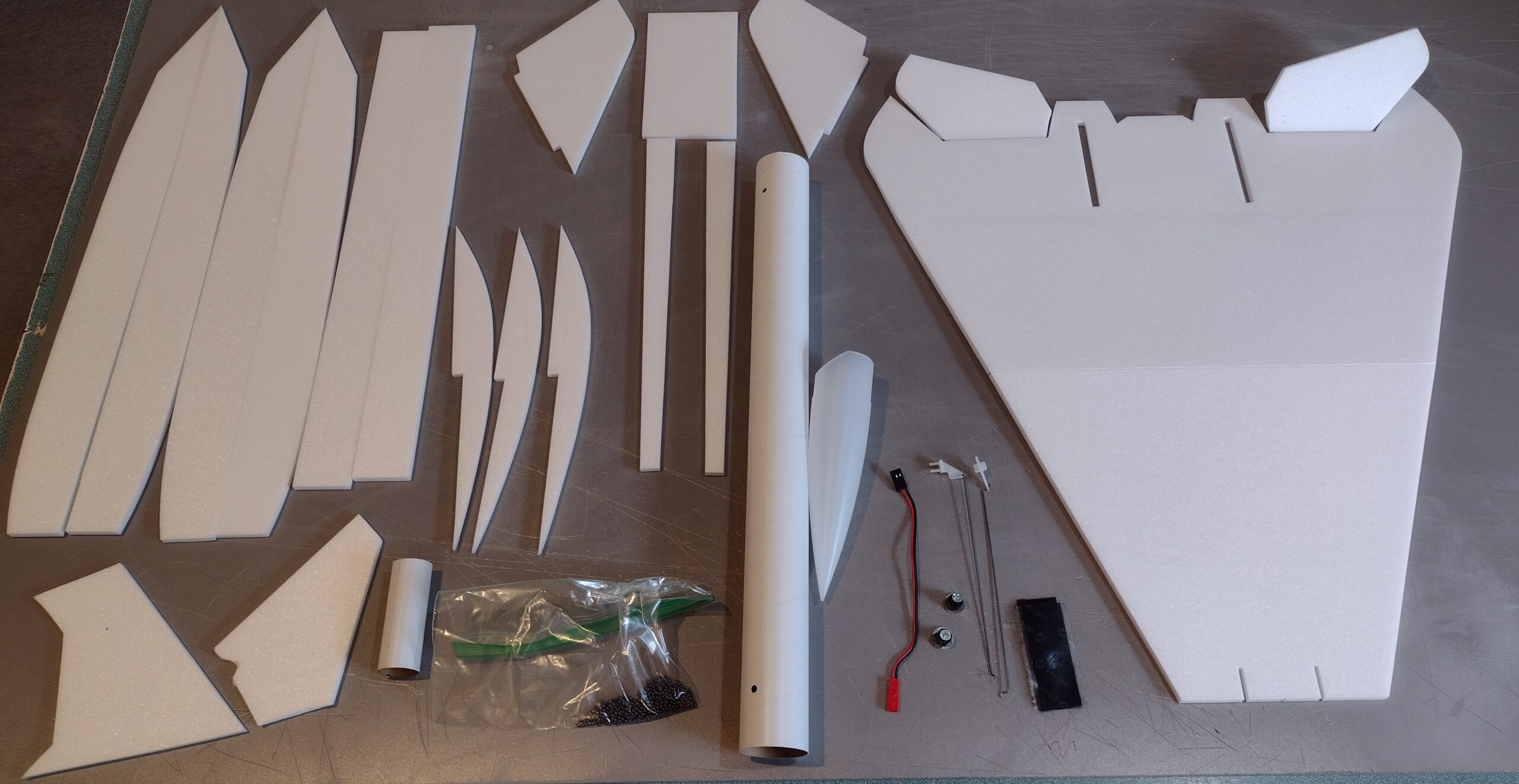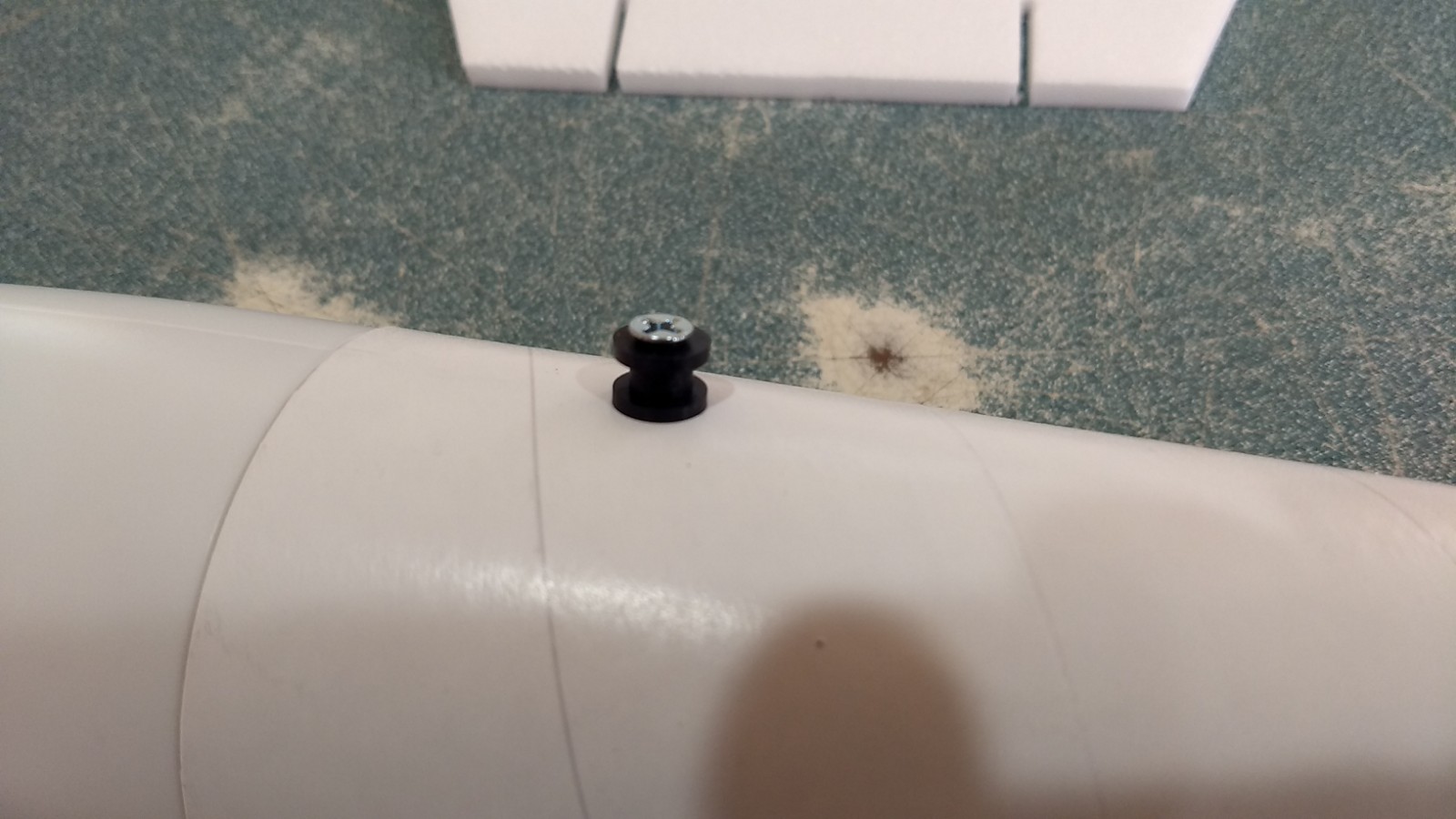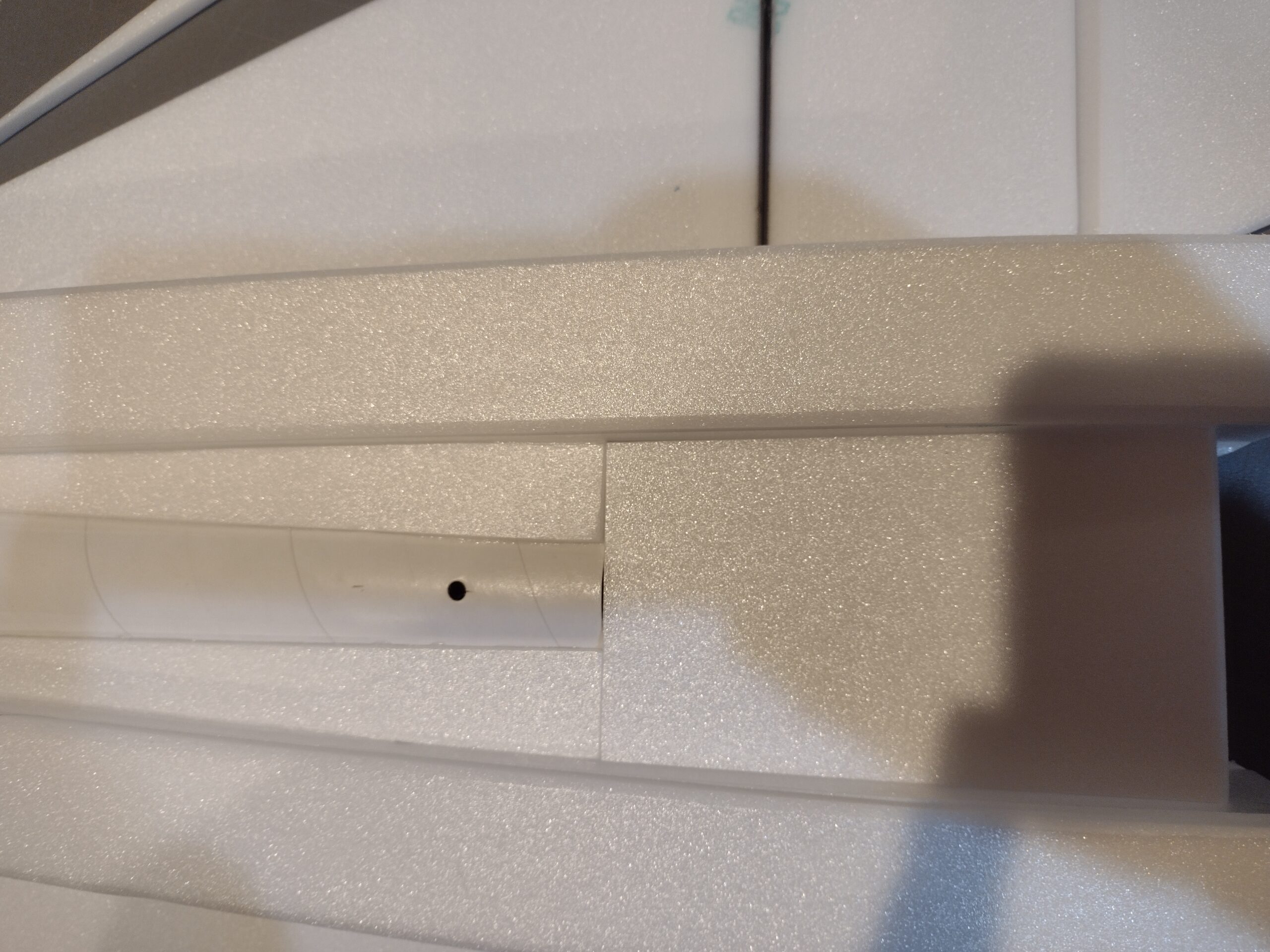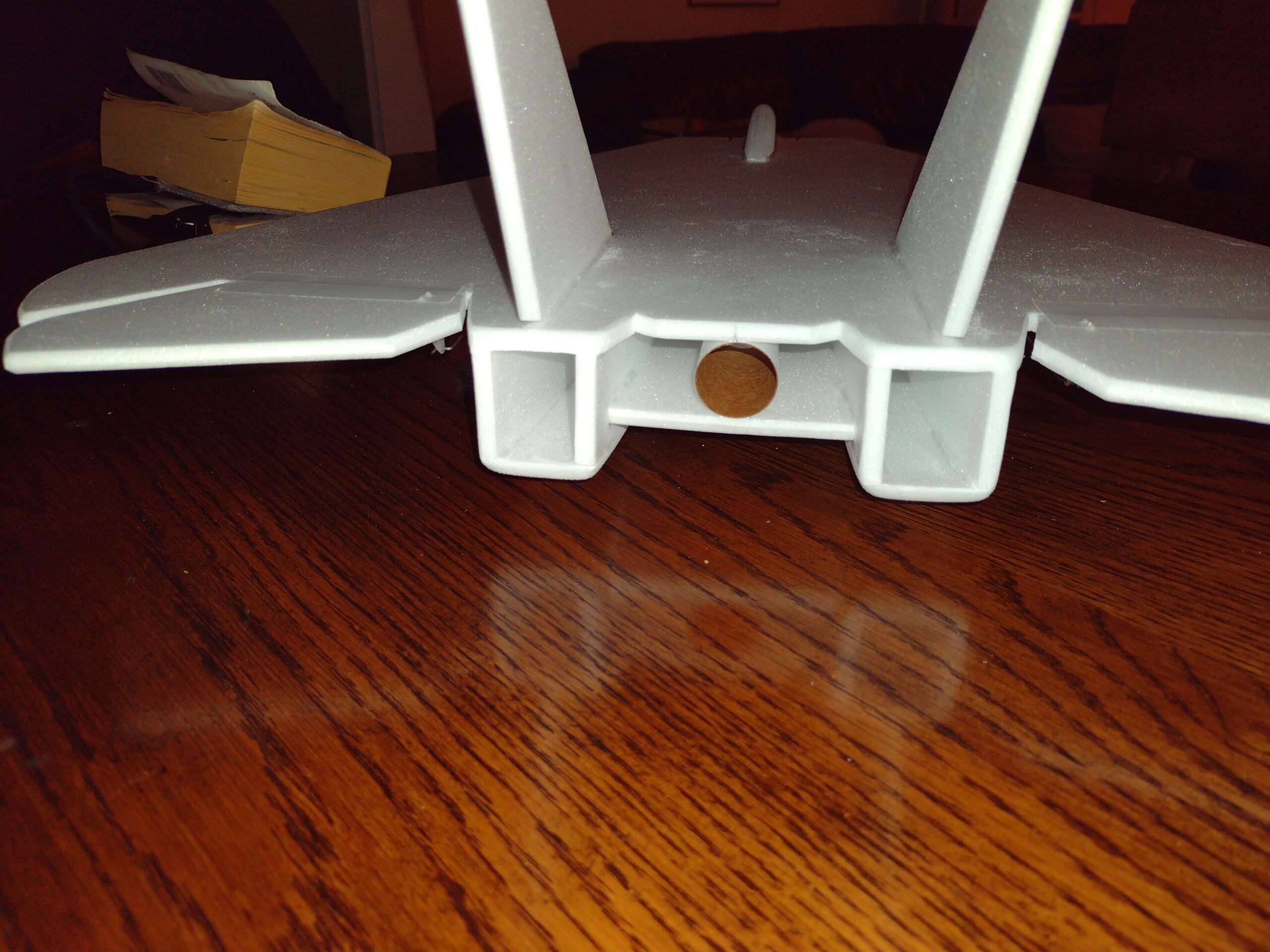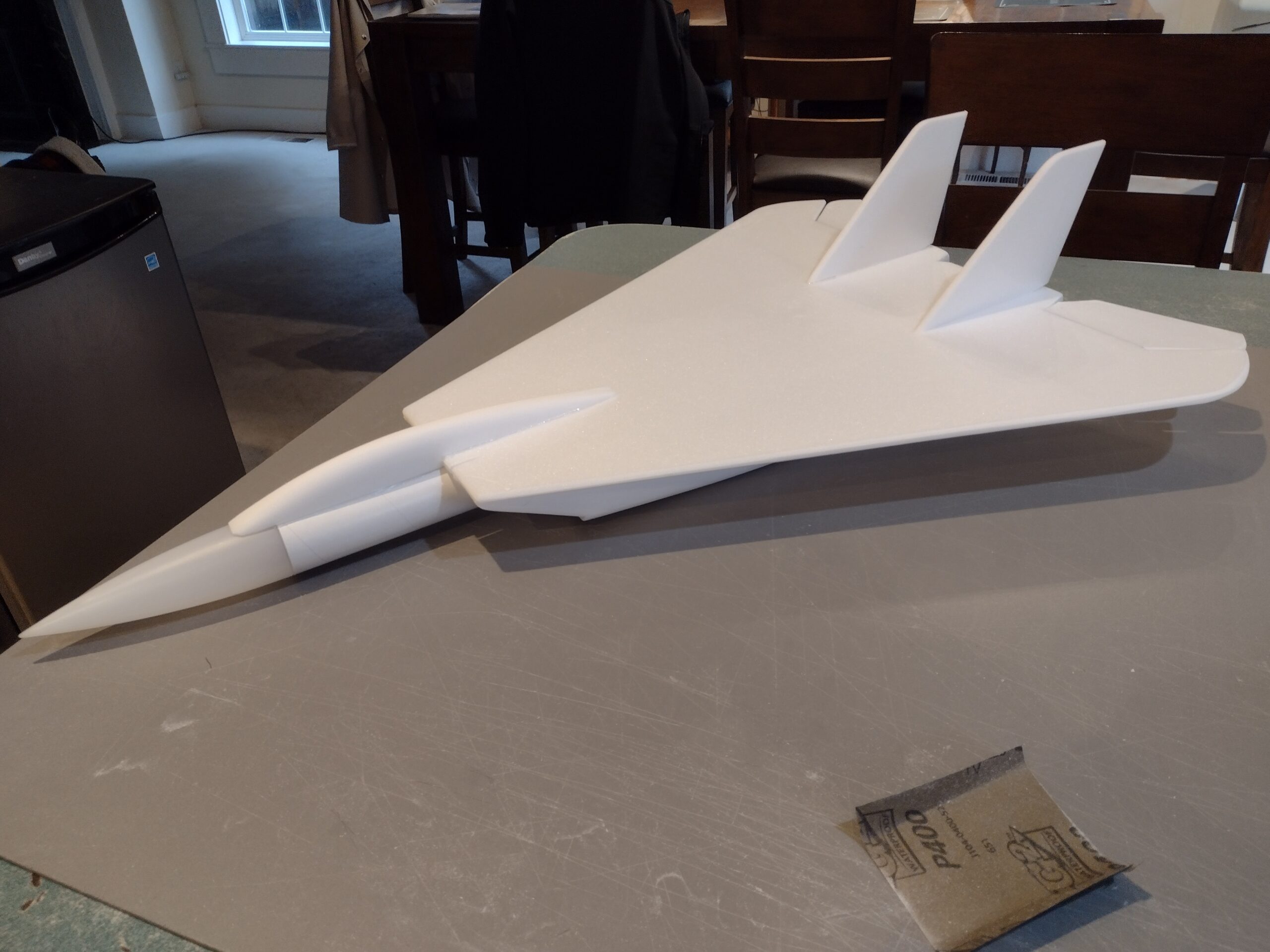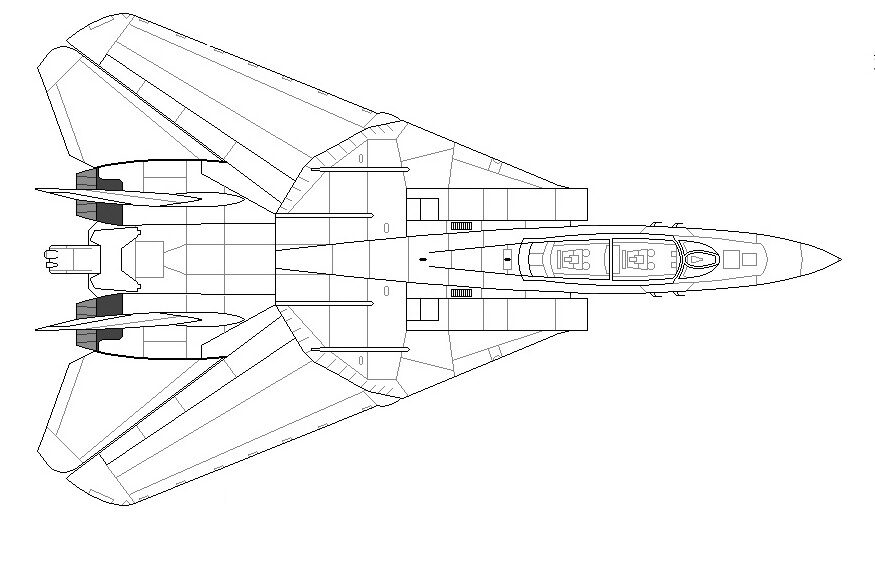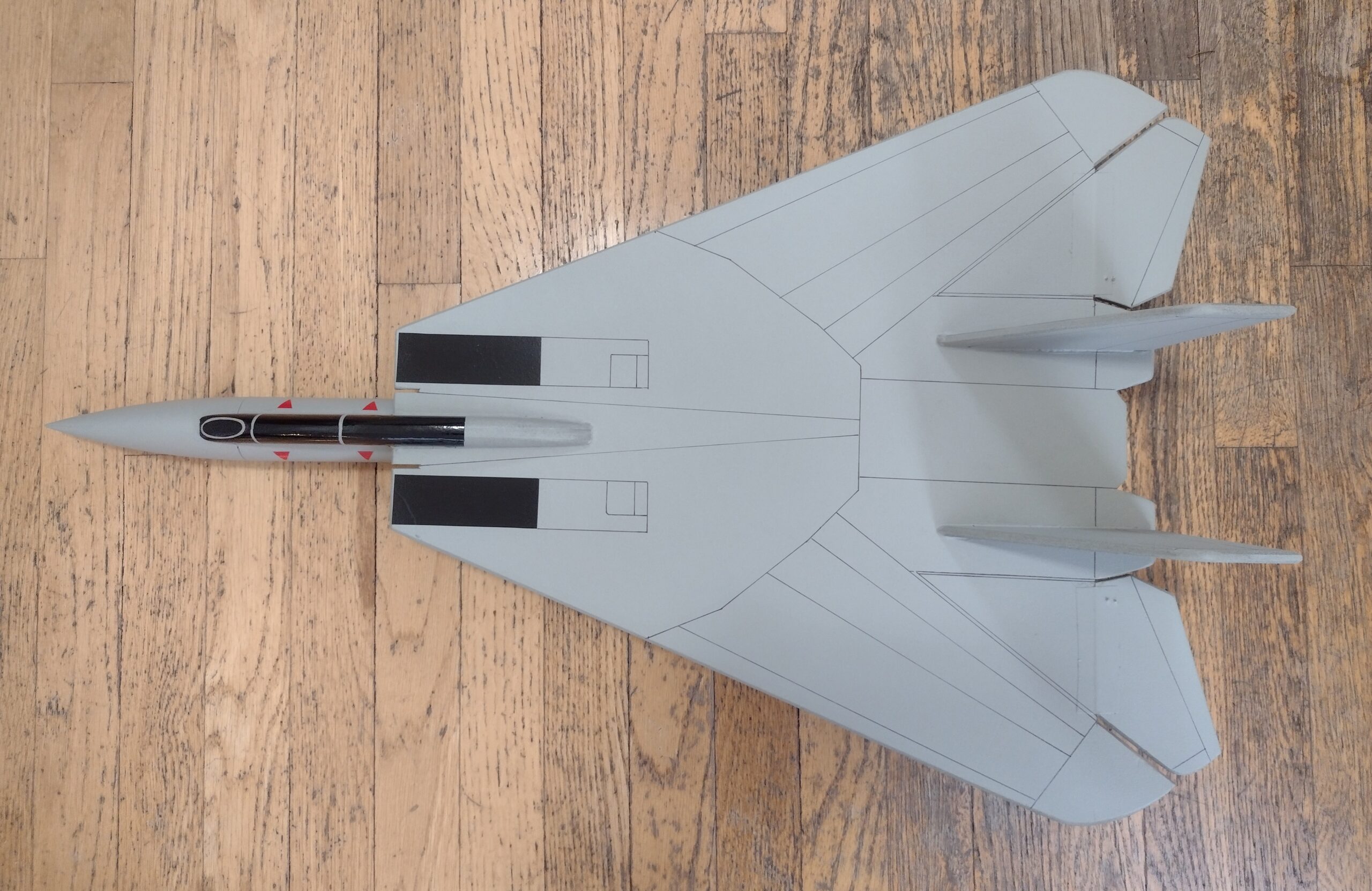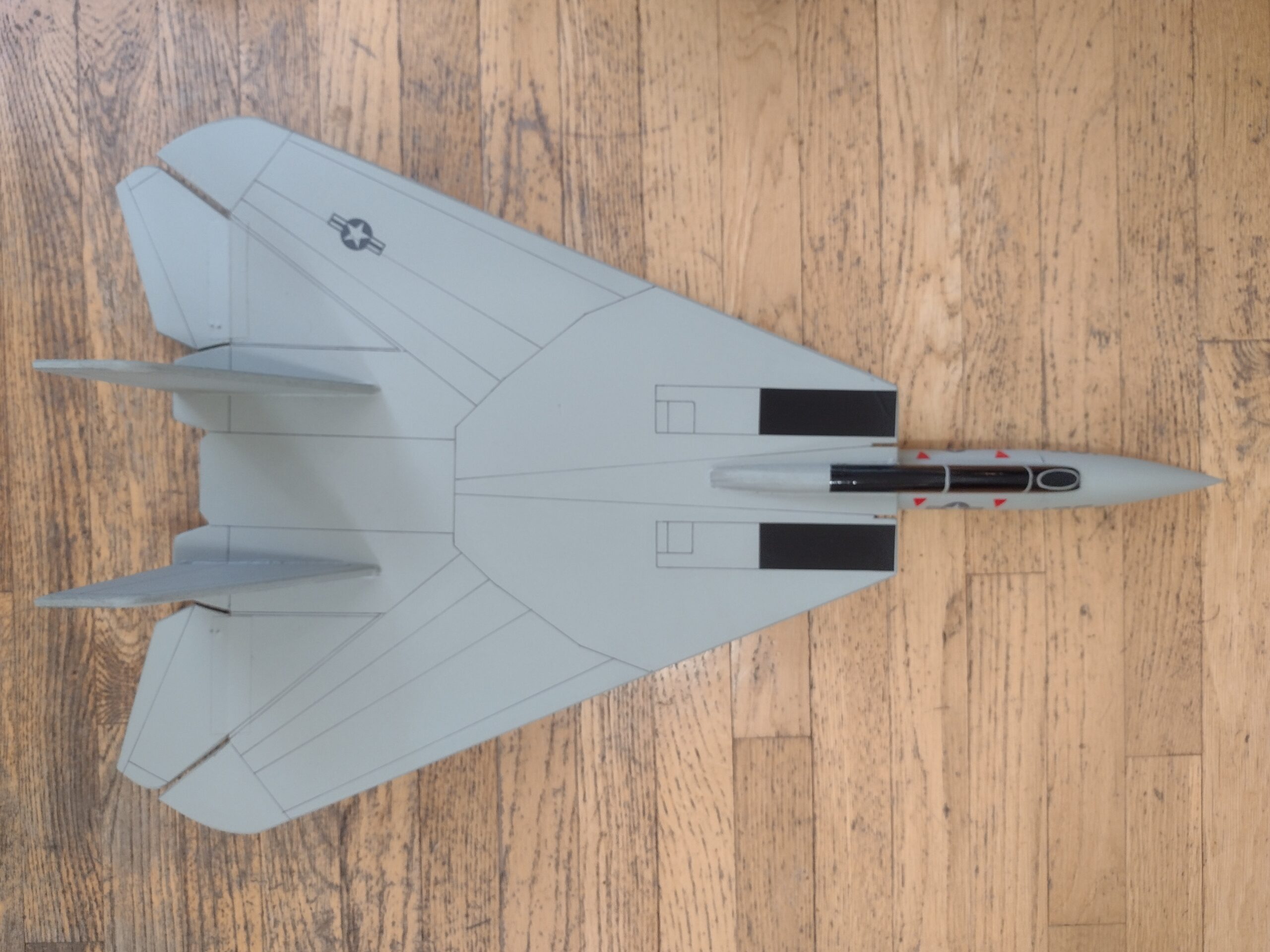
The F-14 Tomcat modeled after the classic Navy Swing wing jet. I’ve updated the kit for 2024 to be lighter and have more scale like construction. The wings are in a fixed swept position which provides the best compromise between ease of construction, strength, light weight and wing loading. The kit includes a body tube with pre-punched rail button holes, plastic nose cone, pre-hinged control surfaces, pre-installed spar and pre-cut 6mm depron wing, tail and fuselage parts. Length 28.5″, wingspan 18″, weight 9.3 oz rtf. This is for Intermediate R/C rocketplane pilots as boost speed is fairly quick and construction has more steps than my simpler kits. For 24mm Aerotech composite E-6 R/C reloads only. You will need two 10 gram type servos, a receiver, and a small 500mah single cell lipo battery. You will need a transmitter with delta or elevon mixing. If you want to order the tail/wing walk and number/star-bar decals from sticker shock you can order them as a set: HERE
CG location for rocket flight with battery and loaded motor installed: 7 3/8 ” to the rear of the leading edge of the wing.
Please refer to the General Information Link above then read the instructions completely before starting assembly. The assembly photos are for general reference but may not include every step in the instructions. If you want hardcopy to work from, all you have to do is click/drag/select and copy all of the text below, open word and paste with “keep original format” and it looks exactly like it does online then you can print it.
Unpacking your kit:
The kits are packed to protect them in shipping, but the contents are fragile so unpack carefully. Carefully cut the tape holding the tubes in the box, then unwrap/lightly cut the plastic wrap to free the tubes, the spar may be packed in the tubes and the baggie with the little parts and nose cone will be in the tubes as well. Carefully cut the tape holding the cardboard wing protector in the box and carefully remove it, don’t pull hard or bend it. Then carefully cut the tape holding the cardboard top piece to the bottom. There may be some sticky tape holding the cardboard to the bottom cardboard piece, carefully peel it being sure not to bend anything. Once the top cardboard is free you can see the foam wing/tail parts, there are little fragile pieces in here, so unwrap carefully. It may be best to use an exacto to lightly cut the plastic wrap and carefully remove it without cutting into the foam. Make sure everything is free before you remove the pieces to avoid breaking anything. Kits contain one or two scrap pieces for repairs if you damage anything in construction or flight, just cut and patch in a spare piece of the foam if needed using foam safe CA+.
Welcome to the world of rocket boosted radio control gliders. This is not a model for a novice RC pilot, but anyone who is comfortable with RC flying of a medium speed model should be fine. Read through the instructions, look at the photos and be sure you understand the step before commiting to cutting or glue.
F-14 Tomcat BT-60 Based Rocket glider instructions:
Identify all pieces, the kit should contain:
1 wing taped together
1 Nose Cone
2 vertical stabilizers
2 control horns w/pushrods
1 Body Tube
Motor mount
4 engine intake side plates.
Two intake bottom plates
1 Rear bottom cover plate
Two tapered Intake/body bottom tube filler strips.
3 cockpit pieces.
Velcro(for battery and rx/bec attachment)
Lead weight
Spare depron
Notes before starting:
Reference to glue, CA, or CA+ means foam safe CA+, normal CA+ will melt the foam! Normally you need to use accelerator to get the CA to set on the foam since there is nothing for it to soak into and activate.
I prefer to use a straight edge and exacto knife to bevel the straight leading and trailing edges of the wing and tail surfaces before a light sanding on the rounded portions with a sanding block and 400 grit paper, use a light touch with the sand paper. Do any beveling before construction.
Epoxy is not needed in this model, use only foam safe CA+ like Bob Smith brand. Weight is critical and the model is designed for the thrust and flight loads for the recommended motors. One step recommends 3m-77 spray adhesive as an option.
Assembly:
- Install the two rail buttons in their respective holes in the body tube, the t nut goes on the inside, then a washer, collar and washer and finally the screw, don’t over tighten.
- Unfold the wing and apply glue to the wing at the taped joint and set it on a flat surface to dry face up. Then flip the wing over, the bottom of the wing will have the spar visible.
- Glue the motor tube onto the bottom of the wing on the line marked, the rear end of the tube will be even with the rear of the wing, try to keep it straight and centered but a little offset won’t hurt anything.
- Apply a squiggle of glue about 1/2 wide to the body tube wing line.
- Glue the body tube to the wing using the line on the body tube and the line on the wing as a guide. The front of the wing should start 4″ to the rear of the front of the body tube, there should be a mark on the body tube at the 4″ mark to help. The rear of the body tube will not go all the way to the motor tube, this allows room for you to feed the servo wires into the tube and up to the nose cone later. Lay the wing flat on a table upside down and make sure the rail buttons are pointing up and the body tube is straight. Make sure it is set before continuing.
- There are four identical intake plates(side views) Glue two intakes on each side of the wing. The rear of the intake is even with the rear of the nozzle cutout on the wing. The front lines up with the outside edge of the front of the wing the rear with the outside edge of the flat cut on the nozzle cutout at the rear. front might overhang the front of the wing slightly, this will be trimmed/sanded later. See pictures for clarity.
- Glue the other two intakes onto the wing, they line up with the inside of the flat rear nozzle cutout on the wing and the inside cutout on the wing leading edge at the front. The intakes should measure 1.5″ accross from outside edge to outside edge so that the bottom plate can be glued to them. You can use the bottom plates as a guide if needed. See Photos for clarity.
- Glue the bottom plates on each intake, the rear is aligned with the rear of the intake you’ll need to hold it down on the curved shape of the intake as the glue dries. The plate is longer than needed so you can trim it even with the front if the intake. You may choose to sand the inside and outside bottom edges of the intakes at this time so they look nice and sand/trim any overhang at the front of the wing.
- Glue the 3 cockpit pieces together, I used 3m-77 spray adhesive but you can use foam safe CA+, it is just harder to sand through the CA so I don’t use glue all the way to the edge of the pieces when gluing when using CA+.
- At this point carve/sand the cockpit round and trim the front and back ends rounded slightly as per the pictures. When done lay it against the front of the wing and body tube/nose cone and check the fit. You may want to wrap some sandpaper around the front of the body tube and sand the front bottom portion of the cockpit assembly slightly to a curve to help it fit better. If you sand too far you may need to trim the cutout at the rear so it will sit against the body tube and wing. Once satisfied glue it in place against the wing and body tube, DO NOT GLUE IT TO THE NOSE CONE! You may need to press and hold the front and rear of the cockpit till it sets. Apply a fillet of glue to the joint once set to help fill in any gaps.
- Test fit the vertical tails into their slots and make sure they fit. The slots are cut at a slight angle so that the tails angle outward slightly. Glue into the slot using foam safe CA+ holding them at a slight angle outward till the glue sets, Try to get the angle about the same on each side, actual angle is not critical.
- Test fit the rear fuselage cover plate and trim/sand to fit. It will fit inbetween the two intakes, butt against the rear of the body tube and be nearly flush with the rear of the motor tube. The intake plate should not stick up above the level of the body tube so that the rail won’t drag on it!
- DO NOT glue the rear plate in place yet till after installing the servos!!
- Test fit and sand the two angle cut long filler pieces to fit in front of the rear cover plate and the body tube and intakes. The fat part goes to the rear. I had to use my exacto or sanding block and bevel the bottom edge that touched the body tube to allow it to sit down level with the the body tube and line up with the rear cover plate. You don’t want it to stick up above the tube and drag on the rail. When happy glue both side fillers in place, if they are a bit long, you can trim the front before gluing.
- Glue each control horn in place on the bottom of the control surface using the pre made holes. The control horn holes should be pointing toward the front of the model. There is a left and right, the pushrod should be on the inside of the horn and angle inward toward the model slightly. Repeat on the other side.
- Put some CA on the top of the control surface where the horn prongs stick through, this locks it in place
The basic construction is now complete.
Radio Installation
Note: Your radio needs to be configured for Delta mixing, this means that the servo arms will move the same direction during elevator stick movement and opposite for aileron stick movement. Connect your servos to the receiver one in the aileron connection and one on the elevator connection and apply power. Use a servo arm at least 9/16” long and with holes small enough that there won’t be slop with the pushrod wire when installed. I use the hole furthest out on the servo arm, to maximize movement. On some servos there are a long two-ended servo arm, you can trim off one end if needed to get sufficient length. Zero out any trim settings on the transmitter.
- Connect a servo extension to each servo lead long enough so that the servo wire can reach the front of the model when installed.
- Connect a servo to each pushrod. If the pushrod is too tight, you can use twist an exacto knife in the servo arm hole to make it larger, but be careful and do not make it too large. Once connected, tape each servo in place so that the control surfaces are centered. Flip the model right side up and look at it from the rear. Moving the transmitter stick back(up elevator) should move both elevons up. Moving the transmitter stick to the right should move the right elevon up and the left elevon down. If you can’t get the servo reversing to give you the right polarity try swapping aileron/elevator inputs to the receiver or turning the servos over and swapping the servo arms to the other side of the output shaft. If that is correct, continue.
- Flip the model upside down and supported. Mark where the servos line up against the outside of the intake, then cutout the intake to fit the servo. Make sure to remove any glue from the side plate/wing joint when you remove the cutout so that the servo can glue to a flat surface.
- Cut a slot into the inside intake and pass the servo wire through the plate and back of the body tube to the front of the model and re-connect to the receiver.
- With the radio still on, test fit the servo into the pocket, make sure the control surface stays level, if not, trim the pocket and shift the servo or adjust with the radio trims.
- Put a small amount of glue on the servo, being careful not to get any near the output shaft. And set it in place on the model keeping the control surface centered and recessed into the pocket. Do the same to the other side. You can put a little on the tabs of the servo as well to lock it in place. Make sure the glue is set before continuing.
- Flip the model back right side up. Make sure the control surfaces are centered, use trims if needed. Now measure the control surface movement. Full elevator movement should be 1” in each direction measured at the outer tip of the elevon, aileron movement should be about 1/2″ either direction. If you fly heavy handed, you may want to use dual rates and cut these movements in half for boost and set the higher throws to the glide switch position or flight mode as you need larger movements in glide when the model is slower.
- If you have a flap/elevator mix you can program up elevator to a switch setting, I use the flap trim function on the D switch on my spektrum DX-8gen2 radio. The model needs approximately 1/4″ to 3/8” of up elevon during glide. You can also use flight modes on a switch to give unique trim for roll and pitch for boost and glide if you dont have flap elevator trim. I use the D switch for flight mode select as well so it gives me an audible “launch mode” and “landing mode” indication to be sure I’ve set the right position. I also set my timer to start when I select the D switch fully down for glide mode so I can see how long my glide time was.
- My model needed aboue 1/8″ of downtrim for vertical boost, you will need to fine tune this in the first few flights as well as the glide setting and any roll trim needed.
- Glue the rear cover plate in place against the rear of the body tube, flush with the top of the tube and against the motor mount at the rear.
- Attach the receiver into the nose cone with provided velcro at the top.
- Attach the flight battery into the bottom of the nose cone with the rest of the provided velcro as far forward as you can reach with your fingers.
- Sand the nose cone with 400 grit paper to rough it up a bit, the plastic has a hard time with paint sticking really well, especially if you want to mask it or screw up your decals and try to pull them off, you may want to try a good plastic adhering primer base on the cone before painting with the testors if you plan on masking the cone.
- Finish the model as desired, see general instructions for paint recommendations and warnings. I painted mine with testors spray dark flat aircraft gray. Mask the rail buttons and servo output arm before painting.
- If you purchase the sticker shock decals refer to the pictures for placement. After application of the vinyl use a hot hair dryer to soften decals and press them in with your thumb to make them set and conform to the model. Do not use a heat gun as it is too hot!
- The cockpit can be painted by hand using any foam safe brushable enamel or latex paint, gloss black or blue looks nice, see pictures for clarity. It is very hard to cut vinyl decals and get them to conform to the rounded cockpit especially with variations in how everyone rounds the foam which is why they are not provided in the decal set from stickershock. It’s easy to paint the entire cockpit, then use some trim tape or thin strips of trim vinyl and add the canopy lines afterward, or use a silver sharpie pen to do the same thing.
- The panel lines can be applied after painting with a black fine line sharpie and a straight edge referring to the line drawing below. I simply draw by freehand on one side and then measure and replicate on the other side. Don’t worry if it isn’t exact, it just adds some neat detail. You can be as elaborate or as simple as you want, sometimes I stop of the model is starting to look too busy or add additional things I make up if it looks plain. Little circles and boxes look like hatches for example.
- Balance the model after you have painted as it adds about 1/2 ounce to the model!
- Insert your heaviest loaded rocket motor into the motor mount and install the flight battery as if you were going to fly it.
- Support the model right side up at the balance point indicated for boost using some chopsticks held in a vice, clamps or wooden blocks. I cut 1/2″ square bits of scrap depron pushed onto the tips of the chopsticks to avoid gouging the wing foam when balancing. This provides a much more accurate balance than using fintertips. Glue just as much nose weight in the nose to balance it slightly nose down. Do not try to fly the model with it balancing it behind this point or significantly nose heavy. The adage is, a nose heavy model flies poorly, a tail heavy model flies once.
Flying: See the General Information link at the top for flying instructions. Be ready on the first few flights to keep the model straight till you have the trims set perfectly for boost and glide.
- Kit Parts
- Install rail buttons at front and back in the pre-made holes if they are not installed already.
- glue the taped joint on the wing then lay flat to dry
- Glue the motor tube in place.
- Glue the body tube on the alignment line, front of tube should be 4″ from front of wing.
- Glue Outer Intake plate on
- Glue other side outer intake plate
- Glue inner intake plate note the spacing and the cutout notch in the wing.
- Rear of the intake plates showing spacing just inside the curved portion of the wing nozzle cutouts.
- Intake plates inner and outer installed.
- Intake bottom plates glue in place.
- Fitting rear bottom cover plate, not it is level with the body tube
- Fit forward bottom angle filler plates
- Filler plates installed.
- Install Vertical Stabs with a slight outward angle.
- Laminate the cockpit pieces
- Round the cockpit and sand the bottom using the the nose cone/body tube and sandpaper.
- Fit then glue the cockpit in place, do NOT glue to the nose cone.
- Glue in the two control horns/pushrods, note how the pushrod is closest to the body tube and the wire naturally angles inward.
- Add some glue to the top of the horn prongs to lock them in place.
- Servo pocket cut into the side intake and glued in place.
- Completed airframe Side view
- Completed airframe Top view
- Completed airframe Bottom view
- Top view for panel line ideas.
- Example of stickershock decal set
